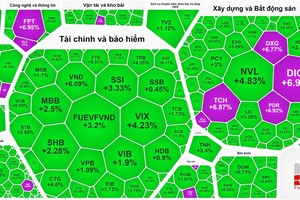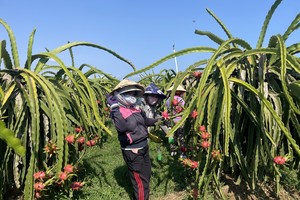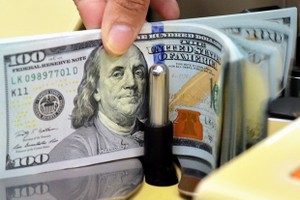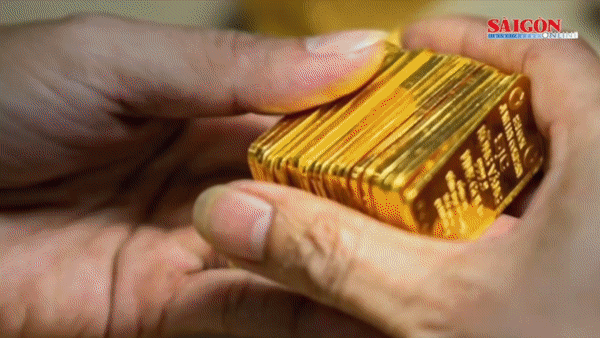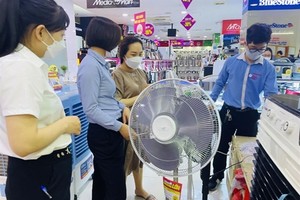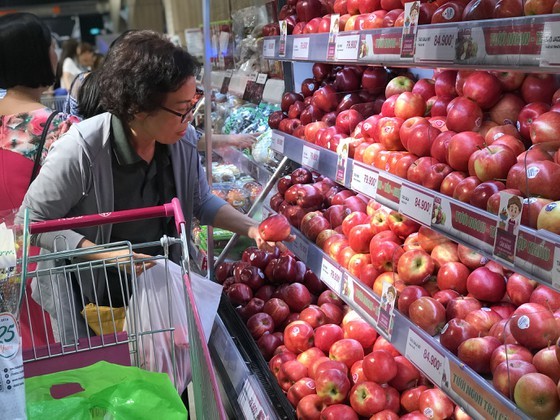
According to the General Department of Vietnam Customs, in the past ten months, Vietnam spent more than $1.5 billion to import vegetables and fruits, mainly fruits. The country imported fruits most from the US with the volume of fruits imported from the US rising by up to 70 percent. Fruits imported from South Africa surged by 39 percent, from New Zealand climbed by 38 percent, from China advanced by 36 percent and from Chile increased by 21 percent.
The Ho Chi Minh City’s market alone had consumed around 800 tons of imported cherries in the first seven months of this year, of which, 349 tons were imported from the US and 250 tons from Australia. Similarly, as for blue berries, during the crop from July to the end of September this year, the volume of fresh blue berries imported from the US by air was up to 350 tons. Thanks to high import volume, prices of exotic fruits also became cheaper. The price of fresh blue berries was merely VND600,000 per kilogram while it was more than VND1 million per kilogram in previous years. The US cherries were priced VND350,000 per kilogram while they cost VND500,000 per kilogram last year. The price of Australia’s Navel oranges was VND80,000 per kilogram while it fetched VND130,000 per kilogram last year.
Moreover, other exotic fruits, such as New Zealand’s kiwis, apples, the US grapes, Australian mandarins and South Africa’s pears, were also imported a lot and their prices were also less expensive. Following the reduction in tariffs of signed free trade agreements, foreign fruits are expected to enter Vietnam even more due to cheaper prices.
Besides import enterprises, this year, many big supermarkets have also negotiated to directly import exotic fruits. Representative of Big C said that thanks to importing without intermediary, the price was cheaper, shipping time was shortened so the quality of fruits was better. In addition, buying in large quantity will receive better prices.
Especially, Vietnam is considered to be a potential market, continuously welcoming foreign business delegation to the country to advertise and promote sale of fruits. Importers also supported supermarkets in trying out their products. The US Highbush Blueberry Council in Vietnam has supported in market development and running promotional programs at 104 stores in 35 cities and provinces in Vietnam.
Similarly, Taste Australia has helped supermarkets in advertising for years so the volume of fruits imported from Australia into Vietnam has surged continuously every year. In the first five months of this year, the volume of cherries imported from Australia was up to 598 tons, up 53 percent compared to last year, the volume of oranges imported from Australia was 4,694 tons, more than two times higher than that in last year. Vietnam currently is the fourth largest grapes importer of Australia, reaching 7,761 tons of grapes this year, up 50 percent compared to last year.
It is hard to believe that in a country with various types of tropical fruits like Vietnam, consumers consume heavily and are fond of imported fruits. Besides the factor of new and unfamiliar taste, the factor of clean fruits is one of the reasons that make Vietnamese consumers willingly spend money on imported fruits. However, when imported fresh fruits land in Vietnamese market and are on dining tables of Vietnamese families, food safety and preservation remain a concern. Why is that?
In his latest market survey, Mr. Jeff Scott, chairman of the Australian Table Grapes Association, said that fresh Australian grapes must be sold at storage temperatures of 1 - 4 degrees Celsius to ensure quality. However, most supermarkets in Vietnam do not preserve grapes at appropriate temperature, affecting the freshness and sweetness of grapes.
In addition, traders usually disguise Chinese fruits as well-known fruits from other countries to sell them at higher prices. For instance, Chinese apples have same colors with apples of New Zealand and Fuji apples of the US. Chinese grapes and cherries look alike US and Australian counterparts in both colors and taste. Chinese pears have the same colors with Korean pears but their taste is less sweet than Korean ones. Chinese oranges were even disguised as Vietnamese oranges.
Only sellers are able to know the true origin of their fruits so consumers should buy exotic fruits from large supermarkets which directly import fruits for their own safety.
In addition, while domestic consumers are spending heavily on imported fruits, exports of Vietnamese fruits are on the decline. Exotic fruits have been imposing pressure on domestic fruits in both local and foreign markets. Chinese market, which consumes a large amount of vegetables and fruits of Vietnam, has also shifted to import more fruits from Thailand and Oceania countries because of high quality and cheap prices.
The Ho Chi Minh City’s market alone had consumed around 800 tons of imported cherries in the first seven months of this year, of which, 349 tons were imported from the US and 250 tons from Australia. Similarly, as for blue berries, during the crop from July to the end of September this year, the volume of fresh blue berries imported from the US by air was up to 350 tons. Thanks to high import volume, prices of exotic fruits also became cheaper. The price of fresh blue berries was merely VND600,000 per kilogram while it was more than VND1 million per kilogram in previous years. The US cherries were priced VND350,000 per kilogram while they cost VND500,000 per kilogram last year. The price of Australia’s Navel oranges was VND80,000 per kilogram while it fetched VND130,000 per kilogram last year.
Moreover, other exotic fruits, such as New Zealand’s kiwis, apples, the US grapes, Australian mandarins and South Africa’s pears, were also imported a lot and their prices were also less expensive. Following the reduction in tariffs of signed free trade agreements, foreign fruits are expected to enter Vietnam even more due to cheaper prices.
Besides import enterprises, this year, many big supermarkets have also negotiated to directly import exotic fruits. Representative of Big C said that thanks to importing without intermediary, the price was cheaper, shipping time was shortened so the quality of fruits was better. In addition, buying in large quantity will receive better prices.
Especially, Vietnam is considered to be a potential market, continuously welcoming foreign business delegation to the country to advertise and promote sale of fruits. Importers also supported supermarkets in trying out their products. The US Highbush Blueberry Council in Vietnam has supported in market development and running promotional programs at 104 stores in 35 cities and provinces in Vietnam.
Similarly, Taste Australia has helped supermarkets in advertising for years so the volume of fruits imported from Australia into Vietnam has surged continuously every year. In the first five months of this year, the volume of cherries imported from Australia was up to 598 tons, up 53 percent compared to last year, the volume of oranges imported from Australia was 4,694 tons, more than two times higher than that in last year. Vietnam currently is the fourth largest grapes importer of Australia, reaching 7,761 tons of grapes this year, up 50 percent compared to last year.
It is hard to believe that in a country with various types of tropical fruits like Vietnam, consumers consume heavily and are fond of imported fruits. Besides the factor of new and unfamiliar taste, the factor of clean fruits is one of the reasons that make Vietnamese consumers willingly spend money on imported fruits. However, when imported fresh fruits land in Vietnamese market and are on dining tables of Vietnamese families, food safety and preservation remain a concern. Why is that?
In his latest market survey, Mr. Jeff Scott, chairman of the Australian Table Grapes Association, said that fresh Australian grapes must be sold at storage temperatures of 1 - 4 degrees Celsius to ensure quality. However, most supermarkets in Vietnam do not preserve grapes at appropriate temperature, affecting the freshness and sweetness of grapes.
In addition, traders usually disguise Chinese fruits as well-known fruits from other countries to sell them at higher prices. For instance, Chinese apples have same colors with apples of New Zealand and Fuji apples of the US. Chinese grapes and cherries look alike US and Australian counterparts in both colors and taste. Chinese pears have the same colors with Korean pears but their taste is less sweet than Korean ones. Chinese oranges were even disguised as Vietnamese oranges.
Only sellers are able to know the true origin of their fruits so consumers should buy exotic fruits from large supermarkets which directly import fruits for their own safety.
In addition, while domestic consumers are spending heavily on imported fruits, exports of Vietnamese fruits are on the decline. Exotic fruits have been imposing pressure on domestic fruits in both local and foreign markets. Chinese market, which consumes a large amount of vegetables and fruits of Vietnam, has also shifted to import more fruits from Thailand and Oceania countries because of high quality and cheap prices.

